Having great products, competitive prices and a great website are the perfect start. But customers need to find your site before they can buy. SEO is a long term strategy that builds lasting benefits for your company but which strategy is right for you?

SEO, in a nutshell, are the strategies and tactics people use to optimise their pages for search engines so they show up higher in the search results. The two main ways to benefit are to appear for as many relevant keywords and phrases as possible and then to appear as high as possible in the search rankings. If you can appear on the first page of Google you’ll get far more visitors to your site and that means more customers and more sales.
Worldwide companies spend over $50 billion a year on SEO. From the largest companies like Amazon and Coca Cola to your local furniture or book store companies have long recognised the benefits of SEO as it provides a lasting benefit and has no limits on how many you can reach unlike Google Ads or Social Media which will cap your exposure based on follower size or ad spend.
But not everyone can appear at the top of Google so it’s important to have a proper SEO strategy, the correct one for you and a strong agency that can do the work for you. In this article we will be focusing on content structures.
Content Hubs
What are Content Hubs?
Content hubs are a method of organizing your website’s content around a central theme or topic. This approach allows you to create a comprehensive resource center on your website, with a central hub page that links to several related pages. By grouping related content together, you can create a more comprehensive and authoritative resource that can help improve your website’s search engine ranking and user engagement. Content hubs are what we create to add organisation to a website’s page structure instead of a site that just has pages branching off in all directions or every page being linked to the homepage.
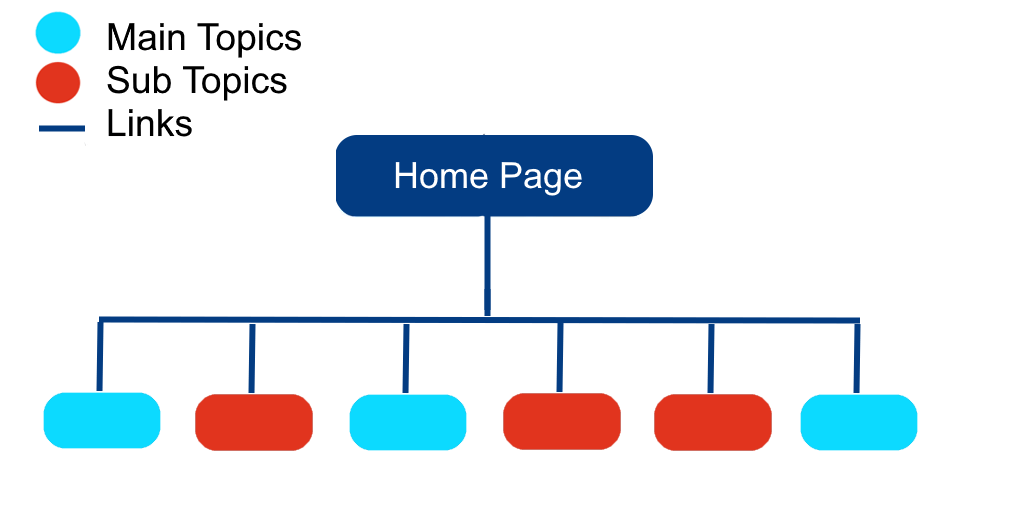
A business that sells skincare products might create a content hub around “Anti-Aging Skincare.” The hub page would provide an overview of anti-aging skincare, while the related pages would cover subtopics such as “How to Choose the Best Anti-Aging Products,” “The Science Behind Anti-Aging Skincare,” and “The Best Anti-Aging Ingredients.”
A travel agency might create a content hub around “European Destinations.” The hub page would provide an overview of European travel, while the related pages would cover subtopics such as “The Best Places to Visit in Italy,” “Tips for Traveling in Spain,” and “The Top Attractions in France.”
There are several types of content hubs such as silo’s, hub and spoke and topic clusters which we will look at in more detail further down the page.
The Benefits of Content Hubs
Improved search engine ranking: According to a study by Searchmetrics, websites that use content hubs rank higher in search engines than those that don’t. By grouping related content together, content hubs signal to search engines that your website is an authoritative source of information on a particular topic, and can help improve your website’s search engine ranking.
Increased user engagement: When users visit your website, they want to find the information they’re looking for quickly and easily. Content hubs make it easier for users to navigate through related content, reducing bounce rates and increasing time spent on your site.
Greater content organization: By grouping your content into a central hub, you can create a logical and intuitive structure that makes it easier for both users and search engines to understand the main topics and subtopics of your website.
Increased click-through rates: According to a study by HubSpot, websites that use content hubs have a 97% higher click-through rate than those that don’t. By linking related content together, you can increase the likelihood that users will click through to other pages on your website.
Cost-effective: Content hubs can be a cost-effective SEO strategy, as they focus on leveraging existing content rather than creating new content from scratch.
Creating a Content Hub
When creating a content hub, there are a few steps you should follow:
Choose a central topic: Your content hub should revolve around a central theme or topic that is relevant to your business and your audience.
Create a hub page: This page should provide an overview of the topic and link to the related subtopic pages.
Identify subtopics: Brainstorm subtopics that are related to the central theme and that your audience will find valuable.
Create subtopic pages: Create pages that cover each subtopic in-depth and link back to the hub page.
Optimize for SEO: Ensure that each page is optimized for search engines by using relevant keywords and meta descriptions.
Conclusions on Content Hubs
In today’s digital landscape, content is king, and content hubs are an effective way to organize your website’s content and improve your SEO efforts. By grouping related content together, you can create a more comprehensive and authoritative resource for your audience, while also signaling to search engines that your website is an expert on a particular topic. While creating a content hub requires significant planning and organization, the benefits can be substantial, including improved search engine ranking, increased user engagement, and greater content organization. If you’re looking for a way to take your website’s content strategy to the next level, consider implementing a content hub today.
Silo Structures
Overall, cornerstone content can be an effective way to improve your website’s search engine optimization, establish your authority in a particular area, and increase engagement with your audience. By creating comprehensive, in-depth content that covers a specific topic, you can position your website as a valuable resource for your audience and improve your overall content strategy. However, it’s important to keep in mind the potential limitations of this approach, including the need for time and resources, limited flexibility, and a limited scope.
If you’re considering incorporating cornerstone content into your website’s content strategy, it’s important to approach the process with a clear plan in mind. Determine your niche and target audience, and choose topics that are both relevant to your audience and align with your brand’s expertise. Be prepared to invest time and resources into creating high-quality, comprehensive content, and consider ways to promote and share your cornerstone content to maximize its impact.
Ultimately, by creating cornerstone content that provides value to your audience, you can establish your website as a trusted resource in your niche, improve your search engine visibility, and drive more traffic to your site. With a strategic approach and a commitment to quality, cornerstone content can be a powerful tool in your overall content marketing strategy.
What are Silo Structures
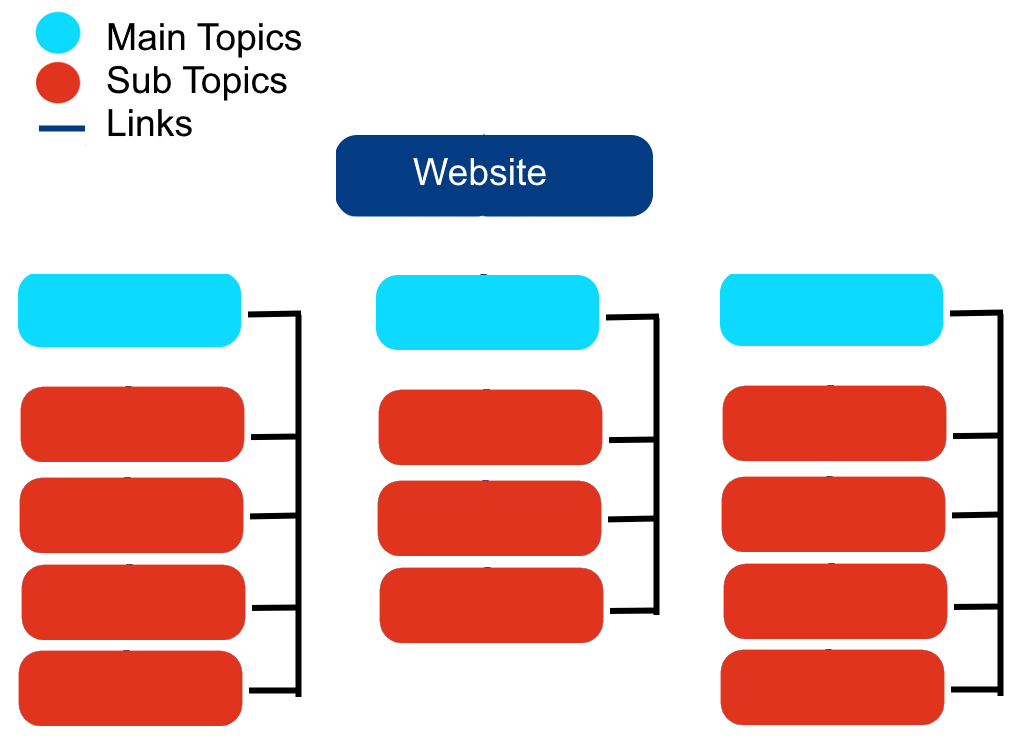
If you’re looking to improve your website’s search engine ranking and overall user experience, you may want to consider implementing a silo structure. Silos are an SEO strategy that involves organizing your website’s content into distinct, focused sections or “silos.”
A silo structure involves organizing your website’s content into distinct sections or silos, each focused on a specific topic or keyword. These silos are interconnected, with each linking to the others in a hierarchical structure. The idea behind silos is to create a website that is easier for search engines to crawl and understand, as well as more intuitive for users to navigate.
A travel website might use a silo structure to organize content around different destinations, with each silo focused on a specific city or region. For example, there might be silos for “Europe,” “Asia,” and “South America,” with each linking to sub-silos focused on individual countries or cities.
An e-commerce website might use a silo structure to organize content around different product categories, with each silo focused on a specific type of product. For example, there might be silos for “Electronics,” “Home Appliances,” and “Fashion,” with each linking to sub-silos focused on individual products or brands.
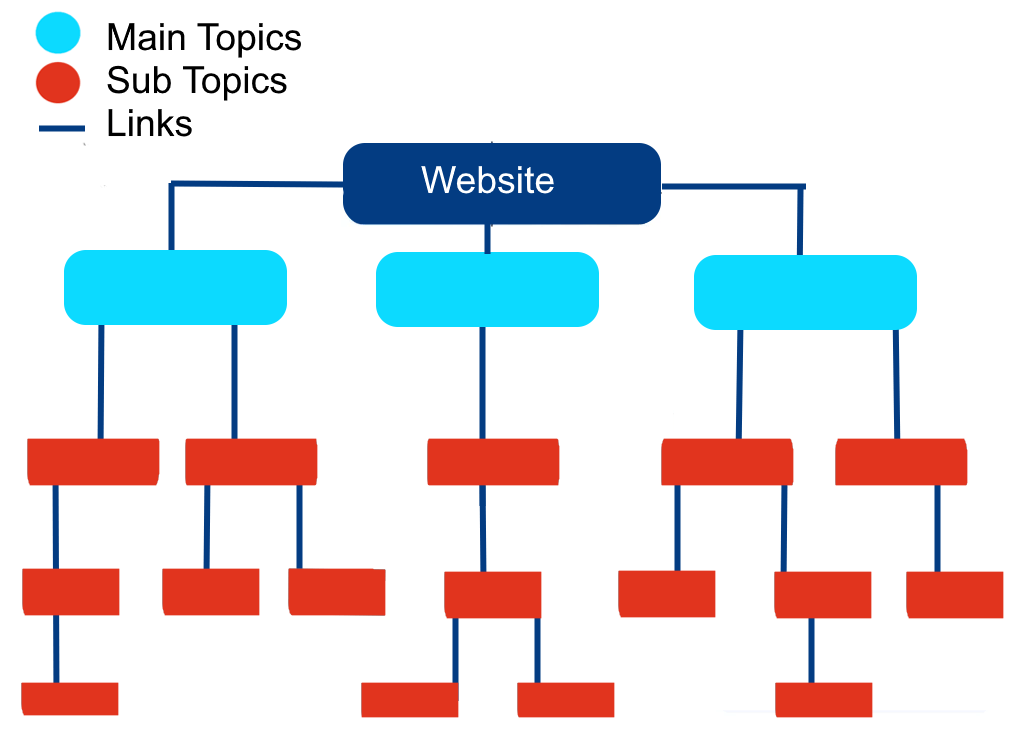
Benefits of Silo Structures
Improved search engine ranking: By organizing your website’s content into silos, you can signal to search engines that your website is an expert on a particular topic. This can lead to improved search engine ranking and increased visibility for your website.
Better user experience: A silo structure can make it easier for users to find the content they’re looking for on your website, improving their overall experience and reducing bounce rates.
Easier to manage: Silos can make it easier to manage your website’s content, as each section is focused on a specific topic or keyword.
Limitations of Silo Structures
Potential for oversimplification: Silos can sometimes oversimplify complex topics or make it difficult to cross-reference related content.
Time-consuming to implement: Implementing a silo structure can be time-consuming, especially for large websites with a lot of content.
Creating Silo Structures
Conduct keyword research: Before you start creating your silo structure, conduct keyword research to identify the main topics and subtopics that are relevant to your website.
Choose your main silos: Based on your keyword research, choose your main silos. These should be the broadest topics that you want to cover on your website. For example, if you have a website about fitness, your main silos might be “cardio,” “strength training,” “nutrition,” and “recovery.”
Create sub-silos: Once you have identified your main silos, create sub-silos for each one. These sub-silos should be more specific and focused than your main silos. For example, under the “cardio” silo, you might have sub-silos like “running,” “cycling,” and “HIIT workouts.”
Organize your content: Once you have your silos and sub-silos, organize your existing content into the appropriate silos. You may need to create new content to fill in any gaps or ensure that each silo has enough content to be valuable.
Create internal links: Create internal links between related pieces of content within each silo. This will help search engines understand the structure of your website and ensure that users can easily find related content.
Update and maintain: Over time, continue to update and maintain your silo structure. Regularly add new content and update existing content to ensure that it remains relevant and valuable to your audience. This will also help improve your search engine rankings and drive more traffic to your website.
Conclusion
Silo structures can be a highly effective way to improve your website’s search engine ranking and overall user experience. By organizing your website’s content into distinct, focused sections or silos, you can create a more comprehensive and authoritative resource for your audience, while also signaling to search engines that your website is an expert on a particular topic. While creating a silo structure can be time-consuming, the benefits can be substantial, including improved search engine ranking, increased user engagement while still remaining easier to manage as compared to other strategies.
Topic Clusters
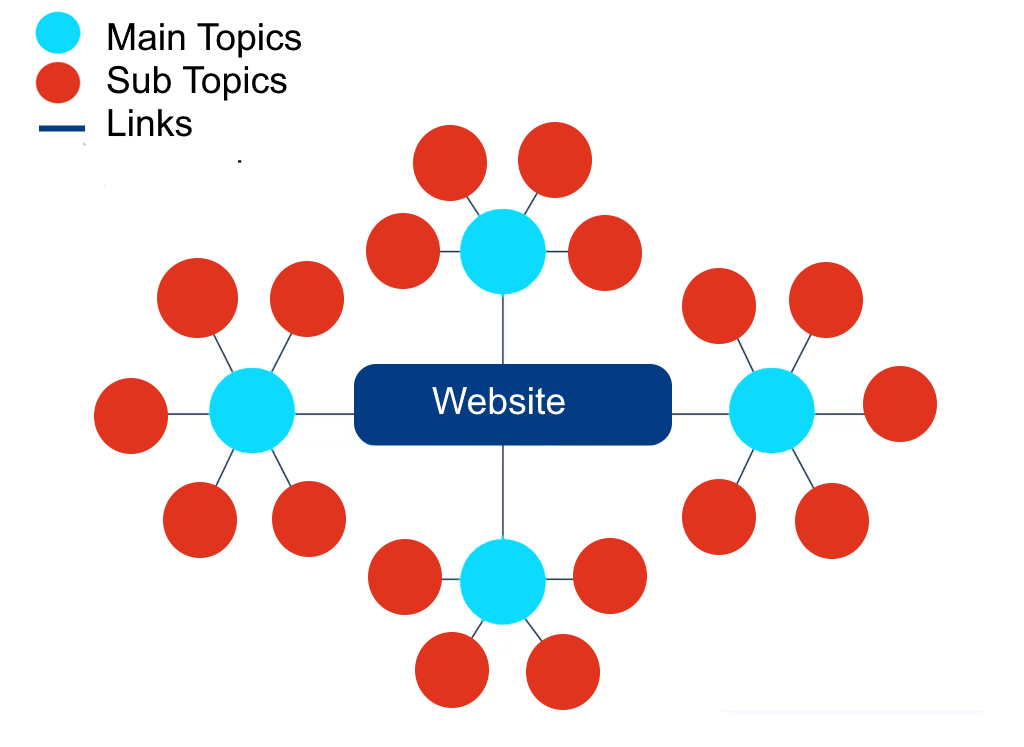
What are Topic Clusters
Topic clusters are a way of organizing and interlinking content on your website to improve its search engine ranking. In a topic cluster, a single “pillar” page is created that provides a comprehensive overview of a particular topic. This pillar page is then linked to a series of related content pages or “cluster” pages, each of which covers a subtopic related to the main topic.
A business that sells outdoor gear might create a topic cluster around camping. The pillar page would provide an overview of camping, while the cluster pages would cover subtopics such as camping gear, camping recipes, and camping safety. A law firm might create a topic cluster around personal injury law. The pillar page would provide an overview of personal injury law, while the cluster pages would cover subtopics such as car accidents, slip and falls, and medical malpractice.
A marketing agency might create a topic cluster around content marketing. The pillar page would provide an overview of content marketing, while the cluster pages would cover subtopics such as blog writing, social media marketing, and email marketing.
Benefits of Topic Clusters
Greater content organization: Topic clusters help you organize your content into a logical and intuitive structure, making it easier for both users and search engines to understand the main topics and subtopics of your website.
Increased click-through rates: By linking related content together, you can increase the likelihood that users will click through to other pages on your website.
Increased click-through rates: According to a study by Conductor, websites that use topic clusters have a 2.3x higher click-through rate than those that don’t. By linking related content together, you can increase the likelihood that users will click through to other pages on your website.
Cost-effective: Topic clusters can be a cost-effective SEO strategy, as they focus on leveraging existing content rather than creating new content from scratch.
Limitations of Topic Clusters
May not be suitable for all types of content: Topic clusters work best for content that can be broken down into clear subtopics. For more complex or nuanced content, a different organizational structure may be more appropriate.
Requires significant planning and organization: Creating a topic cluster requires careful planning and organization to ensure that all the content is properly linked and that the overall structure is logical and intuitive.
Can be time-consuming: Creating a comprehensive pillar page and a series of related content pages can be time-consuming, particularly for businesses with limited resources.
Creating Topic Clusters
Choose your core topic: Choose a core topic that is relevant to your business and your target audience. This topic should be broad enough to cover all the key aspects of your niche or industry, but specific enough to be useful to your readers.
Conduct keyword research: Conduct keyword research to identify the subtopics that are relevant to your core topic.
Create subtopics: Based on your keyword research, create subtopics that are closely related to your core topic. Each subtopic should be a specific area of interest within your niche or industry.
Create content for each subtopic: Create high-quality content for each subtopic, using your keyword research as a guide. This content should be informative, engaging, and useful to your target audience.
Link to your pillar page: Link each piece of content back to your core topic or pillar page. This will help search engines understand the structure of your content and ensure that users can easily find related content.
Update and maintain: Over time, continue to update and maintain your topic cluster. Regularly add new content and update existing content to ensure that it remains relevant and valuable to your audience. This will also help improve your search engine rankings and drive more traffic to your website.
Monitor and adjust: Monitor the performance of your topic cluster over time and adjust your content strategy as needed. Use tools like Google Analytics to track your traffic and engagement metrics and make data-driven decisions about your content.
Conclusion
Topic clusters are an effective SEO strategy that can help improve your website’s search engine ranking, user experience, content organization, and click-through rates. While they do require careful planning and organization, the benefits they offer make them a worthwhile investment for many businesses. By creating a comprehensive pillar page and a series of related content pages, you can demonstrate to search engines and users alike that your website is an authoritative source of information on a particular topic.
Hub and Spoke Model
What is the Hub and Spoke Model
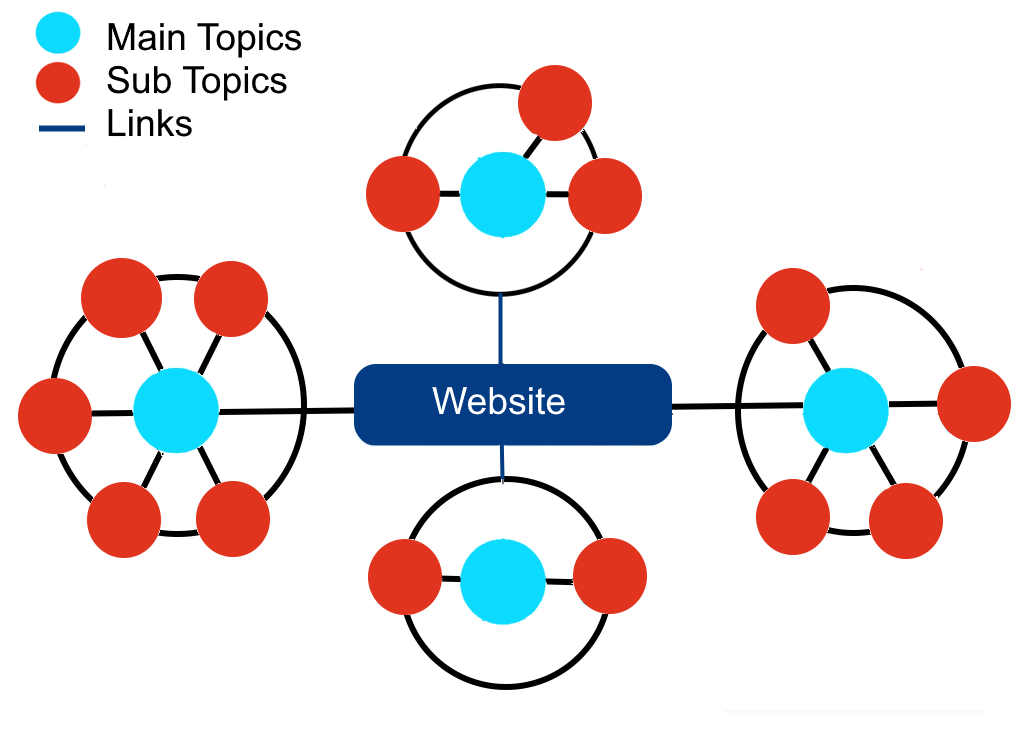
The hub and spoke model is an SEO strategy that involves creating a central hub of content that links out to related, more specific content pages, or “spokes.” The idea behind this approach is to create a comprehensive and interlinked network of content that makes it easy for users to find and explore related topics.
A cooking website might use the hub and spoke model to organize content around different types of cuisine, with each hub focused on a specific type of cuisine, such as Italian, Chinese, or Indian. Each spoke would then be a more specific topic related to that type of cuisine, such as “pasta recipes” or “curry recipes.”
A health and wellness website might use the hub and spoke model to organize content around different health topics, with each hub focused on a specific topic, such as “nutrition” or “fitness.” Each spoke would then be a more specific sub-topic related to that topic, such as “healthy eating tips” or “yoga poses.”
Benefits of the Hub and Spoke Model
Improved user experience: The hub and spoke model makes it easy for users to find and explore related content on your website, improving their overall experience and reducing bounce rates.
Improved search engine ranking: By creating a comprehensive and interlinked network of content, you can signal to search engines that your website is an authoritative source on a particular topic. This can lead to improved search engine ranking and increased visibility for your website.
Easier to manage: The hub and spoke model can make it easier to manage your website’s content, as each spoke is focused on a specific topic or sub-topic.
Limitations of the Hub and Spoke Model
Potential for oversimplification: The hub and spoke model can sometimes oversimplify complex topics or make it difficult to cross-reference related content.
Time-consuming to implement: Implementing the hub and spoke model can be time-consuming, especially for large websites with a lot of content.
Creating a Hub and Spoke Model
When creating a hub and spoke model, there are a few steps you should follow:
Choose a central hub: Your central hub should be a comprehensive guide to a particular topic or theme that is relevant to your business and your audience.
Identify spokes: Identify the more specific topics or sub-topics related to your central hub.
Create content pages for each spoke: Create a dedicated content page for each spoke, with relevant and useful information related to that topic.
Link to spokes from the hub: Link to each spoke from your central hub, using relevant anchor text and descriptive titles.
Optimize for SEO: Ensure that each page is optimized for search engines by using relevant keywords and meta descriptions.
Conclusion
The hub and spoke model is an effective way to organize and structure your website’s content, providing a comprehensive and interlinked network of information that is easy for users to navigate and explore. By creating a central hub of content that links out to more specific spokes, you can improve the user experience, increase search engine visibility, and make it easier to manage your website’s content.
While there are some potential limitations to the hub and spoke model, such as the potential for oversimplification and the time required to implement the strategy, the benefits of this approach make it a valuable tool for businesses looking to improve their online presence.
If you’re considering using the hub and spoke model for your website, be sure to choose a central hub that is relevant and comprehensive, identify specific spokes that are relevant to your audience, and optimize each page for search engines. With the right approach, the hub and spoke model can be an effective way to improve your website’s content organization and SEO performance.

